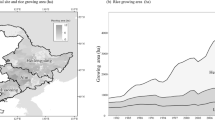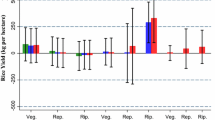Abstract
Temperature is the principal factor that determines rice growth, development and ultimately grain yield. In this study, normal growing-degree-days (NGDD) and killing growing-degree-days (KGDD) were used to capture the different effects of normal and extreme temperatures on rice yields, respectively. Based on these indexes, we assessed the contributions of temperature variations to county-level rice yields across China during the historical period (1980–2008), and estimated the potential exposure of rice to extreme temperature stress in the near future (2021–2050). The results showed that historical temperature variations had measurable impacts on rice yields with a distinct spatial pattern: for different regions, such variations had contributed much to the increased rice yields in Northeast China (Region I) (0.59 % yield year−1) and some portions of the Yunnan-Guizhou Plateau (Region II) (0.34 % yield year−1), but seriously hindered the improvements of rice yields in the Sichuan Basin (SB) (−0.29 % yield year−1) and the southern cultivation areas (Region IV) (−0.17 % yield year−1); for the entire country, half of the contributions were positive and the other half were negative, resulting in a balance pattern with an average of 0.01 % yield year−1. Under the RCP8.5 scenario, climate warming during 2021–2050 would substantially reduce cold stress but increase heat stress in the rice planting areas across China. For the future period, Region I, II and eastern China would be continually exposed to more severe cold stress than the other regions; Region III (including SB and the mid-lower reaches of Yangtze River (MLRYR)) would be the hot spot of heat stress.





Similar content being viewed by others
References
Alexander LV, Zhang X, Peterson TC, Caesar J, Gleason B, Klein Tank A, Haylock M, Collins D, Trewin B, Rahimzadeh F (2006) Global observed changes in daily climate extremes of temperature and precipitation. J Geophys Res 111:D5109
Butler EE, Huybers P (2013) Adaptation of Us maize to temperature variations. Nat Clim Chang 3:68–72
Challinor AJ, Wheeler TR, Craufurd PQ, Slingo JM (2005) Simulation of the impact of high temperature stress on annual crop yields. Agric For Meteorol 135(1–4):180–189
Confalonieri R, Acutis M, Bellocchi G, Donatelli M (2009) Multi-metric evaluation of the models warm, cropsyst, and wofost for rice. Ecol Model 220(11):1395–1410
Cheajesadagul P, Arnaudguilhem C, Shiowatana J, Siripinyanond A, Szpunar J (2013) Discrimination of geographical origin of rice based on multi-element fingerprinting by high resolution inductively coupled plasma mass spectrometry. Food Chem 141(4):3504–3509
FAO (2010) FAOSTAT database 2010. http://www.fao.org/fishery/org/GlobalRecord/en. Accessed 14 July 2010
Gao S, Wang P (2009) Impacts of high temperature stress on rice production in the mid-lower Yangtze River Valley of China. Meteorological Press, Beijing (in Chinese)
GB/T 21985–2008 (2008) Temperature index of high temperature harm for main crops. China Standards Press, Beijing (in Chinese)
Gourdji SM, Sibley AM, Lobell DB (2013) Global crop exposure to critical high temperatures in the reproductive period: historical trends and future projections. Environ Res Lett 8(2):024041
Hansen J, Sato M, Ruedy R (2012) Perception of climate change. Proc Natl Acad Sci U S A 109(37):E2415–E2423
Ikeda S, Nagasaka T (2011) An emergent framework of disaster risk government towards innovating coping capability for reducing disaster risks in local communities. Int J Disaster Risk Sci 2(2):1–9
Krishnan P, Ramakrishnan B, Reddy KR, Reddy VR (2011) High-temperature effects on rice growth, yield, and grain quality. Adv Agron 111:87–206
Liu G (1983) Three cardinal temperatures of crop. Sci Technol Tianjin Agric For 2:47 (in Chinese)
Liu X, Zhang Z, Shuai J, Wang P, Shi W, Chen Y, Tao F (2013) Impact of chilling injury and global warming on rice yield in Heilongjiang Province. J Geogr Sci 23(1):85–97
Lobell DB, Sibley A, Ortiz-Monasterio JI (2012) Extreme heat effects on wheat senescence in India. Nat Clim Chang 2(3):186–189
Lobell DB, Banziger M, Magorokosho C, Vivek B (2011a) Nonlinear heat effects on African maize as evidenced by historical yield trials. Nat Clim Chang 1(1):42–45
Lobell DB, Schlenker W, Costa-Roberts J (2011b) Climate trends and global crop production since 1980. Science 333(6042):616–620
McMaster GS, Wilhelm WW (1997) Growing degree-days: one equation, two interpretations. Agric For Meteorol 87:291–300
Ma S, Wang Q, Wang C, Huo Z (2011) Climate risk and economy vulnerability of rice chilling damage and division in Northeast China. Geogr Res 5:17 (in Chinese with English abstract)
Maltais-Landry G, Lobell DB (2012) Evaluating the contribution of weather to maize and wheat yield trends in 12 US counties. Agron J 104(2):301–311
Meinshausen M, Meinshausen N, Hare W, Raper SC, Frieler K, Knutti R, Frame DJ, Allen MR (2009) Greenhouse-gas emission targets for limiting global warming to 2°C. Nature 458(7242):1158–1162
Moriondo M, Giannakopoulos C, Bindi M (2011) Climate change impact assessment: the role of climate extremes in crop yield simulation. Clim Chang 104(3–4):679–701
Qian B, Zhang X, Chen K, Feng Y, O'Brien T (2010) Observed long-term trends for agroclimatic conditions in Canada. J Appl Meteorol Climatol 49(4):604–618
QX/T 101–2009 (2009) Grade of chilling damage for rice and maize. Meteorological Press, Beijing (in Chinese)
Rane J, Nagarajan S (2004) High temperature index—for field evaluation of heat tolerance in wheat varieties. Agric Syst 79(2):243–255
Robertson SM, Jeffrey SR, Unterschultz JR, Boxall PC (2013) Estimating yield response to temperature and identifying critical temperatures for annual crops in the Canadian prairie region. Can J Plant Sci 93(6):1237–1247
Schlenker W, Roberts MJ (2009) Nonlinear temperature effects indicate severe damages to US crop yields under climate change. Proc Natl Acad Sci U S A 106(37):15594–15598
Seck PA, Diagne A, Mohanty S, Wopereis MC (2012) Crops that feed the world 7: rice. Food Secur 4(1):7–24
Shi P, Ye Q, Han G, Li N, Wang M, Fang W, Liu Y (2012) Living with global climate diversity-suggestions on international governance for coping with climate change risk. Int J Disaster Risk Sci 3(4):177–184
Soule J (1985) Glossary for horticultural crops. John Wiley & Sons, New York
Sun W, Huang Y (2011) Global warming over the period 1961–2008 did not increase high-temperature stress but did reduce low-temperature stress in irrigated rice across China. Agric For Meteorol 151(9):1193–1201
Tao F, Zhang S, Zhang Z (2013) Changes in rice disasters across China in recent decades and the meteotological and agronomic causes. Reg Environ Chang 13(4):743–759
Tao F, Zhang Z, Zhang S, Zhu Z, Shi W (2012) Response of crop yields to climate trends since 1980 in China. Clim Res 54:233–247
Tao F, Yokozawa M, Xu Y, Hayashi Y, Zhang Z (2006) Climate changes and trends in phenology and yields of field crops in China, 1981–2000. Agric For Meteorol 138(1):82–92
Teixeira EI, Fischer G, van Velthuizen H, Walter C, Ewert F (2013) Global hot-spots of heat stress on agricultural crops due to climate change. Agric For Meteorol 170:206–215
Warszawski L, Frieler K, Huber V, Piontek F, Serdeczny O, Schewe J (2013) The inter-sectoral impact model intercomparison project (ISI-MIP): project framework. Proc Natl Acad Sci (USA): 201312330
Wang S, Ma S, Chen L, Wang Q, Huang J (2009) Chilling injury of crops. China Meteorological Press, Beijing (in Chinese)
Wang Y, Xue Y, Li J (2005) Towards molecular breeding and improvement of rice in China. Trends Plant Sci 10(12):610–614
Yang X, Lin E, Ma S, Ju H, Guo L, Xiong W, Li Y, Xu Y (2007) Adaptation of agriculture to warming in Northeast China. Clim Chang 84(1):45–58
Yin X, Kropff MJ, McLaren G, Visperas RM (1995) A nonlinear model for crop development as a function of temperature. Agric For Meteorol 77(1):1–16
Yu Y, Huang Y, Zhang W (2012) Changes in rice yields in China since 1980 associated with cultivar improvement, climate and crop management. Field Crop Res 136:65–75
Zhang S, Tao F, Zhang Z (2014a) Rice reproductive growth duration increased despite of negative impacts of climate warming across China during 1981–2009. Eur J Agron 54:70–83
Zhang Z, Liu X, Wang P, Shuai J, Chen Y, Song X, Tao F (2014b) The heat deficit index depicts the responses of rice yield to climate change in the northeastern three provinces of China. Reg Environ Chang 14(1):27–38
Zhang T, Zhu J, Wassmann R (2010) Responses of rice yields to recent climate change in China: an empirical assessment based on long-term observations at different spatial scales (1981–2005). Agric For Meteorol 150(7–8):1128–1137
Zheng X, Kang W, Zhao T, Luo Y, Duan C, Chen J (2008) Long term trends in sunshine duration over Yunnan-Guizhou plateau in Southwest China for 1961–2005. Geophys Res Lett 35, L15707
Acknowledgments
This study was funded by the National Basic Research Program of China (2012CB955404), the Programme of Introducing Talents of Discipline to Universities (B08008), and the Integrated Risk Governance Project (2013DFG20710) by the Ministry of Science and Technology of China.
Author information
Authors and Affiliations
Corresponding author
Rights and permissions
About this article
Cite this article
Wang, P., Zhang, Z., Song, X. et al. Temperature variations and rice yields in China: historical contributions and future trends. Climatic Change 124, 777–789 (2014). https://doi.org/10.1007/s10584-014-1136-x
Received:
Accepted:
Published:
Issue Date:
DOI: https://doi.org/10.1007/s10584-014-1136-x




